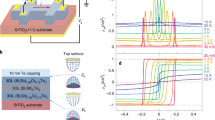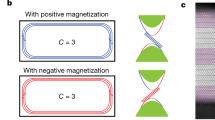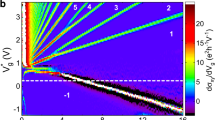Abstract
A quantum anomalous Hall (QAH) insulator is a topological phase in which the interior is insulating but electrical current flows along the edges of the sample in either a clockwise or counterclockwise direction, as dictated by the spontaneous magnetization orientation. Such a chiral edge current eliminates any backscattering, giving rise to quantized Hall resistance and zero longitudinal resistance. Here we fabricate mesoscopic QAH sandwich Hall bar devices and succeed in switching the edge current chirality through thermally assisted spin–orbit torque (SOT). The well-quantized QAH states before and after SOT switching with opposite edge current chiralities are demonstrated through four- and three-terminal measurements. We show that the SOT responsible for magnetization switching can be generated by both surface and bulk carriers. Our results further our understanding of the interplay between magnetism and topological states and usher in an easy and instantaneous method to manipulate the QAH state.
This is a preview of subscription content, access via your institution
Access options
Access Nature and 54 other Nature Portfolio journals
Get Nature+, our best-value online-access subscription
$29.99 / 30 days
cancel any time
Subscribe to this journal
Receive 12 print issues and online access
$259.00 per year
only $21.58 per issue
Buy this article
- Purchase on Springer Link
- Instant access to full article PDF
Prices may be subject to local taxes which are calculated during checkout





Similar content being viewed by others
Data availability
The datasets generated during and/or analysed during this study are available from the corresponding author upon reasonable request.
References
Qi, X. L. & Zhang, S. C. Topological insulators and superconductors. Rev. Mod. Phys. 83, 1057–1110 (2011).
Hasan, M. Z. & Kane, C. L. Colloquium: topological Insulators. Rev. Mod. Phys. 82, 3045–3067 (2010).
Chang, C.-Z., Liu, C.-X. & MacDonald, A. H. Colloquium: quantum anomalous Hall effect. Rev. Mod. Phys. 95, 011002 (2023).
Haldane, F. D. M. Model for a quantum Hall effect without Landau levels: condensed-matter realization of the ‘parity anomaly’. Phys. Rev. Lett. 61, 2015–2018 (1988).
Qi, X. L., Hughes, T. L. & Zhang, S. C. Topological field theory of time-reversal invariant insulators. Phys. Rev. B 78, 195424 (2008).
Liu, C. X., Qi, X. L., Dai, X., Fang, Z. & Zhang, S. C. Quantum anomalous Hall effect in Hg1−yMnyTe quantum wells. Phys. Rev. Lett. 101, 146802 (2008).
Yu, R. et al. Quantized anomalous Hall effect in magnetic topological insulators. Science 329, 61–64 (2010).
Chang, C. Z. et al. Experimental observation of the quantum anomalous Hall effect in a magnetic topological insulator. Science 340, 167–170 (2013).
Chang, C. Z. et al. High-precision realization of robust quantum anomalous Hall state in a hard ferromagnetic topological insulator. Nat. Mater. 14, 473–477 (2015).
von Klitzing, K., Dorda, G. & Pepper, M. New method for high-accuracy determination of the fine-structure constant based on quantized Hall resistance. Phys. Rev. Lett. 45, 494–497 (1980).
Kou, X. F. et al. Scale-invariant quantum anomalous Hall effect in magnetic topological insulators beyond the two-dimensional limit. Phys. Rev. Lett. 113, 137201 (2014).
Checkelsky, J. G. et al. Trajectory of the anomalous Hall effect towards the quantized state in a ferromagnetic topological insulator. Nat. Phys. 10, 731–736 (2014).
Ou, Y. et al. Enhancing the quantum anomalous Hall effect by magnetic codoping in a topological insulator. Adv. Mater. 30, 1703062 (2017).
Zhao, Y. F. et al. Tuning the Chern number in quantum anomalous Hall insulators. Nature 588, 419–423 (2020).
Mogi, M. et al. Magnetic modulation doping in topological insulators toward higher-temperature quantum anomalous Hall effect. Appl. Phys. Lett. 107, 182401 (2015).
Tokura, Y., Yasuda, K. & Tsukazaki, A. Magnetic topological insulators. Nat. Rev. Phys. 1, 126–143 (2019).
Manchon, A. et al. Current-induced spin–orbit torques in ferromagnetic and antiferromagnetic systems. Rev. Mod. Phys. 91, 035004 (2019).
Fan, Y. B. et al. Electric-field control of spin–orbit torque in a magnetically doped topological insulator. Nat. Nanotechnol. 11, 352 (2016).
Han, J. H. et al. Room-temperature spin–orbit torque switching induced by a topological Insulator. Phys. Rev. Lett. 119, 077702 (2017).
Mogi, M. et al. Current-induced switching of proximity-induced ferromagnetic surface states in a topological insulator. Nat. Commun. 12, 1404 (2021).
Wu, H. et al. Room-temperature spin–orbit torque from topological surface states. Phys. Rev. Lett. 123, 207205 (2019).
Fan, Y. B. et al. Magnetization switching through giant spin–orbit torque in a magnetically doped topological insulator heterostructure. Nat. Mater. 13, 699–704 (2014).
Yasuda, K. et al. Current-nonlinear Hall effect and spin–orbit torque magnetization switching in a magnetic topological insulator. Phys. Rev. Lett. 119, 137204 (2017).
Edelstein, V. M. Spin polarization of conduction electrons induced by electric current in two-dimensional asymmetric electron systems. Solid State Commun. 73, 233–235 (1990).
Zhou, L.-J. et al. Confinement-induced chiral edge channel interaction in quantum anomalous Hall insulators. Phys. Rev. Lett. 130, 086201 (2023).
Chang, C. Z. et al. Zero-field dissipationless chiral edge transport and the nature of dissipation in the quantum anomalous Hall state. Phys. Rev. Lett. 115, 057206 (2015).
Wang, J., Lian, B. & Zhang, S. C. Universal scaling of the quantum anomalous Hall plateau transition. Phys. Rev. B 89, 085106 (2014).
Lee, D. H., Wang, Z. Q. & Kivelson, S. Quantum percolation and plateau transitions in the quantum Hall effect. Phys. Rev. Lett. 70, 4130–4133 (1993).
Jiang, J. et al. Concurrence of quantum anomalous Hall and topological Hall effects in magnetic topological insulator sandwich heterostructures. Nat. Mater. 19, 732–737 (2020).
Garello, K. et al. Ultrafast magnetization switching by spin–orbit torques. Appl. Phys. Lett. 105, 212402 (2014).
Liu, L. Q. et al. Spin-torque switching with the giant spin Hall effect of tantalum. Science 336, 555–558 (2012).
Liu, L. Q., Lee, O. J., Gudmundsen, T. J., Ralph, D. C. & Buhrman, R. A. Current-induced switching of perpendicularly magnetized magnetic layers using spin torque from the spin Hall effect. Phys. Rev. Lett. 109, 096602 (2012).
Chang, C. Z. et al. Observation of the quantum anomalous Hall insulator to Anderson insulator quantum phase transition and its scaling behavior. Phys. Rev. Lett. 117, 126802 (2016).
Fox, E. J. et al. Part-per-million quantization and current-induced breakdown of the quantum anomalous Hall effect. Phys. Rev. B 98, 075145 (2018).
Lippertz, G. et al. Current-induced breakdown of the quantum anomalous Hall effect. Phys. Rev. B 106, 045419 (2022).
Mellnik, A. R. et al. Spin-transfer torque generated by a topological insulator. Nature 511, 449–451 (2014).
Ghosh, S. & Manchon, A. Spin–orbit torque in a three-dimensional topological insulator–ferromagnet heterostructure: crossover between bulk and surface transport. Phys. Rev. B 97, 134402 (2018).
Garate, I. & Franz, M. Inverse spin-galvanic effect in the interface between a topological insulator and a ferromagnet. Phys. Rev. Lett. 104, 146802 (2010).
Ndiaye, P. B. et al. Dirac spin–orbit torques and charge pumping at the surface of topological insulators. Phys. Rev. B 96, 014408 (2017).
Liu, C. X. et al. Model Hamiltonian for topological insulators. Phys. Rev. B 82, 045122 (2010).
Zhao, Y.-F. et al. Zero magnetic field plateau phase transition in higher Chern number quantum anomalous Hall insulators. Phys. Rev. Lett. 128, 216801 (2022).
Mahan, G. D. Many-Particle Physics 2nd edn (Springer, 1990).
Acknowledgements
We thank Y.-T. Cui, Y.-B. Fan, I. Garate, L.-Q. Liu, A. H. MacDonald, N. Samarth, J. Shi, W.-D. Wu, D. Xiao and X.-D. Xu for helpful discussions. This work is primarily supported by an ARO Award (W911NF2210159) (C.-Z.C.), including sample synthesis and device fabrication. The PPMS measurements are supported by an AFOSR grant (FA9550-21-1-0177) (C.-Z.C.) and an NSF-CAREER award (DMR-1847811) (C.-Z.C.). The theoretical calculations and simulations are supported by the Penn State MRSEC for Nanoscale Science (DMR-2011839) (C.-X.L. and C.-Z.C.) and an NSF grant (DMR-2241327) (C.-X.L. and C.-Z.C.). C.-Z.C. acknowledges the support from the Gordon and Betty Moore Foundation EPiQS Initiative (GBMF9063 to C.-Z.C.).
Author information
Authors and Affiliations
Contributions
C.-Z.C. conceived and designed the experiment. Y.-F.Z. and D.Z. grew the QAH sandwich samples. L.-J.Z. fabricated the Hall bar devices using electron-beam lithography. W.Y., L.-J.Z., R.Z., Z.Y., Y.W., H.Y., M.H.W.C. and M.K. performed the electrical-transport measurements. K.Y., R.M. and C.-X.L. carried out the numerical simulations and provided theoretical support. W.Y., K.Y., C.-X.L. and C.-Z.C. analysed the data and wrote the manuscript with inputs from all authors.
Corresponding authors
Ethics declarations
Competing interests
The authors declare no competing interests.
Peer review
Peer review information
Nature Materials thanks Philip Moll and the other, anonymous, reviewer(s) for their contribution to the peer review of this work.
Additional information
Publisher’s note Springer Nature remains neutral with regard to jurisdictional claims in published maps and institutional affiliations.
Extended data
Extended Data Fig. 1 QAH state in Device A (w = 5 μm).
a, The optical photograph of Device A. The effective area of the Hall bar device is 20 μm × 5 μm. b, Temperature dependence of ρyx(0) (blue squares) and ρxx(0) (red circles) at Vg = Vg0. All measurements are taken at μ0H = 0 T after magnetic field training. The critical temperature of the QAH state in Device A is ~5.3 K. c, d, μ0H dependence of ρyx and ρxx measured at different temperatures and Vg = Vg0.
Extended Data Fig. 2 SOT-induced magnetization switching under different in-plane magnetic fields in Device A.
a, Current pulse Ipulse dependence of ρyx under different μ0H|| at T = 20 mK. The corresponding current pulse density Jpulse is shown on the upper horizontal axis. The hysteresis loops reflect the reversal of magnetization direction. All these SOT switching measurements are done at ρyx ~ 0.27 h/e2. The data curves are vertically shifted for clarity. b, μ0H|| dependence of the Hall resistance change Δρyx at T = 20 mK. Δρyx is maximized near μ0H|| = +0.05 T, so we choose |μ0H||| = 0.05 T for the SOT-induced magnetization switching in Device A.
Extended Data Fig. 3 More magneto-transport properties of Device A.
a, μ0H dependence of ρyx without tuning Vg after SOT switching at ρyx(0) ~ 0.27 h/e2 and T = 20 mK. After SOT-induced switching, ρyx(0) is ~ −0.225 h/e2. After applying μ0H ~ 0.5 T to align the magnetization, ρyx(0) ~ 0.268 h/e2. Therefore, the SOT magnetization switching ratio at ρyx(0) ~ 0.27 h/e2 by applying |Ipulse|~200 μA under μ0H|| = +0.05 T is ~ 0.225/0.268 = 83.9%. Here the switching ratio is defined as the absolute value of the zero magnetic field Hall resistance ratio before and after magnetic training. When the sample magnetization is fully aligned, the negligible ρyx difference suggests the gating effect induced by the injection of Ipulse is much weaker when the SOT switching is done at |ρyx(0)| ~0.27 h/e2. The red dashed curve corresponds to the initial magnetization process after SOT switching. b, μ0H|| dependence of ρyx at T = 20 mK when the sample is tuned to ρyx(0) ~ 0.27 h/e2. We find that the anisotropy field K is ~0.7 T and thus the sample magnetization almost points upward and downward under |μ0H||| = 0.05 T.
Extended Data Fig. 4 Electrical switching of edge current chirality in Device A through bulk and surface carriers generated SOT.
a, Gate (Vg − Vg0) dependence of ρyx(0) (blue) and ρxx(0) (red) of the QAH insulator after the fourth switch with Ipulse ~ −200 μA under μ0H|| = −0.05 T. The SOT switching is done at ρyx(0) ~ −0.27 h/e2 and T = 20 mK. b, μ0H dependence of ρyx at Vg = Vg0 and T = 20 mK after the fourth switch. The red dashed curve corresponds to the initial magnetization process after the SOT switching. c, Summary of all four switches of CEC chirality at T = 20 mK. The CEC chirality can be switched by changing the direction of either the in-plane magnetic field or the current pulse. Note that the SOT switching is independent of the initial direction of magnetization M (Supplementary Figs. 11 and 12). Therefore, the reversed magnetization should be independent of the number of switching times.
Extended Data Table. 5 Electrical switching of edge current chirality in Device A at T = 2 K.
a-c, Gate (Vg − Vg0) dependence of ρyx(0) (blue) and ρxx(0) (red) of the QAH insulator with right-handed CEC (that is the initial state) (a), after the first (b) and second (c) switches. d, μ0H dependence of ρyx (blue) and ρxx (red) at Vg = Vg0 and T = 2 K. e, f, μ0H dependence of ρyx at Vg = Vg0 and T = 2 K after the first (e) and second (f) switches, respectively. The red dashed curves correspond to the initial magnetization process after each switch.
Extended Data Fig. 6 QAH state in Device B (w = 2 μm).
a, The optical photograph of Device B. The effective area of the Hall bar device is 8 μm × 2 μm. b, Temperature dependence of ρyx(0) (blue squares) and ρxx(0) (red circles) at Vg = Vg0. All measurements are taken at μ0H = 0 T after magnetic field training. The critical temperature of the QAH state in Device B is ~6.8 K. c, d, μ0H dependence of ρyx and ρxx measured at different temperatures and Vg = Vg0.
Extended Data Fig. 7 Electrical switching of edge current chirality in Device B through bulk and surface carriers generated SOT.
a-c, Gate (Vg − Vg0) dependence of ρyx(0) (blue) and ρxx(0) (red) of the QAH insulator with the right-handed CEC (that is the initial state) (a), after the first switch with Ipulse ~ −100 μA (b) and the second switch with Ipulse ~ 100 μA (c) under μ0H|| ~ +0.05 T. Both SOT switches are done at |ρyx(0)| ~ 0.27 h/e2 and T = 20 mK. d, μ0H dependence of ρyx (blue) and ρxx (red) at Vg = Vg0 and T = 20 mK. e, f, μ0H dependence of ρyx at Vg = Vg0 and T = 20 mK after the first (e) and second (f) switches. The red dashed curves correspond to the initial magnetization process after each switch. Vg0s are +1.0 V, +22.5 V, and +35.5 V for the initial state, after 1st switch, and after 2nd switch, respectively.
Extended Data Fig. 8 More magneto-transport properties of Device B after SOT switching.
a-d, μ0H dependence of ρyx without tuning Vg after SOT switching at ρyx(0) ~ 0.185 h/e2 (a), ~0.275 h/e2 (b), ~0.625 h/e2 (c), and ~0.999 ± 0.001 h/e2 (d), respectively. After SOT-induced switching, the corresponding ρyx(0) is ~ −0.142 h/e2 (a), ~ −0.240 h/e2 (b), ~ −0.489 h/e2 (c), and ~ −0.620 h/e2 (d), respectively. After applying μ0H ~ 0.5 T to align the magnetization, ρyx(0) becomes ~0.184 h/e2 (a), ~0.277 h/e2 (b), ~0.523 h/e2 (c), and ~0.653 h/e2 (d), respectively. The red dashed curve corresponds to the initial magnetization process after each switch. e-g, Three ratios \({\rho }_{yx}^{{\rm{a}}}(0)/{\rho }_{yx}^{{\rm{a}}}\) (0, trained) (e), \({\rho }_{yx}^{{\rm{a}}}(0)/{\rho }_{yx}^{{\rm{b}}}\)(0) (f), \({\rho }_{yx}^{{\rm{a}}}\) (0, trained)/ \({\rho }_{yx}^{{\rm{b}}}\)(0) (g) as a function of ρyxb(0), where the SOT switching is done. ρyxb(0): the zero magnetic field Hall resistance before SOT switching. ρyxa(0): the zero magnetic field Hall resistance after SOT switching. \({\rho }_{yx}^{{\rm{a}}}\)(0, trained): the zero magnetic field Hall resistance after SOT switching and μ0H ~ 0.5 T training. All measurements are taken at T = 20 mK. For the SOT switching done near the QAH regime, the \({\rho }_{yx}^{{\rm{a}}}(0)/{\rho }_{yx}^{{\rm{b}}}(0)\) ratio cannot be used to estimate the magnetization switching ratio since ρyx ∝ M becomes invalid.
Extended Data Fig. 9 SOT-induced magnetization switching under different in-plane magnetic fields in Device B (w = 2 μm).
a, Current pulse Ipulse dependence of ρyx under μ0H|| = +0.05 T (top) and μ0H|| = −0.05 T (bottom) at T = 20 mK. b, Ipulse dependence of ρyx under different μ0H|| at T = 20 mK. The corresponding current pulse density Jpulse in (a) and (b) is shown on the upper horizontal axis. All these SOT switching measurements in (a) and (b) are done at ρyx ~ 0.27 h/e2. The data curves in (b) are vertically shifted for clarity. c, μ0H|| dependence of the Hall resistance change Δρyx at T = 20 mK. Δρyx is maximized near μ0H|| = +0.05 T, so we chose |μ0H||| = 0.05 T for the SOT-induced magnetization switching in Device B. We find that the optimal μ0H|| for the SOT-induced magnetization switching is independent of the width of the QAH Hall bar device.
Extended Data Fig. 10 Electrical switching of edge current chirality in more QAH insulator devices at T = 2 K.
a-f, Gate (Vg − Vg0) dependence of ρyx(0) before (blue) and after (red) SOT magnetization switching in Device C (w = 10 μm) (a), Device D (w = 5 μm) (b), Device B (w = 2 μm) (c), Device E (w = 2 μm) (d), Device F (w = 1 μm) (e), and Device G (w = 1 μm) (f), respectively. The SOT-induced magnetization switching is all done at ρyx(0) ~ 0.155 h/e2 and T = 2 K under μ0H|| ~ +0.05 T. The current pulse Ipulse used for SOT magnetization switching becomes smaller by reducing the width of the QAH Hall bar device.
Supplementary information
Supplementary Information
Supplementary Figs. 1–12, Tables 1 and 2 and Sections 1–13.
Rights and permissions
Springer Nature or its licensor (e.g. a society or other partner) holds exclusive rights to this article under a publishing agreement with the author(s) or other rightsholder(s); author self-archiving of the accepted manuscript version of this article is solely governed by the terms of such publishing agreement and applicable law.
About this article
Cite this article
Yuan, W., Zhou, LJ., Yang, K. et al. Electrical switching of the edge current chirality in quantum anomalous Hall insulators. Nat. Mater. 23, 58–64 (2024). https://doi.org/10.1038/s41563-023-01694-y
Received:
Accepted:
Published:
Issue Date:
DOI: https://doi.org/10.1038/s41563-023-01694-y
This article is cited by
-
All-electric writing of a chiral quantum memory
Nature Materials (2023)



